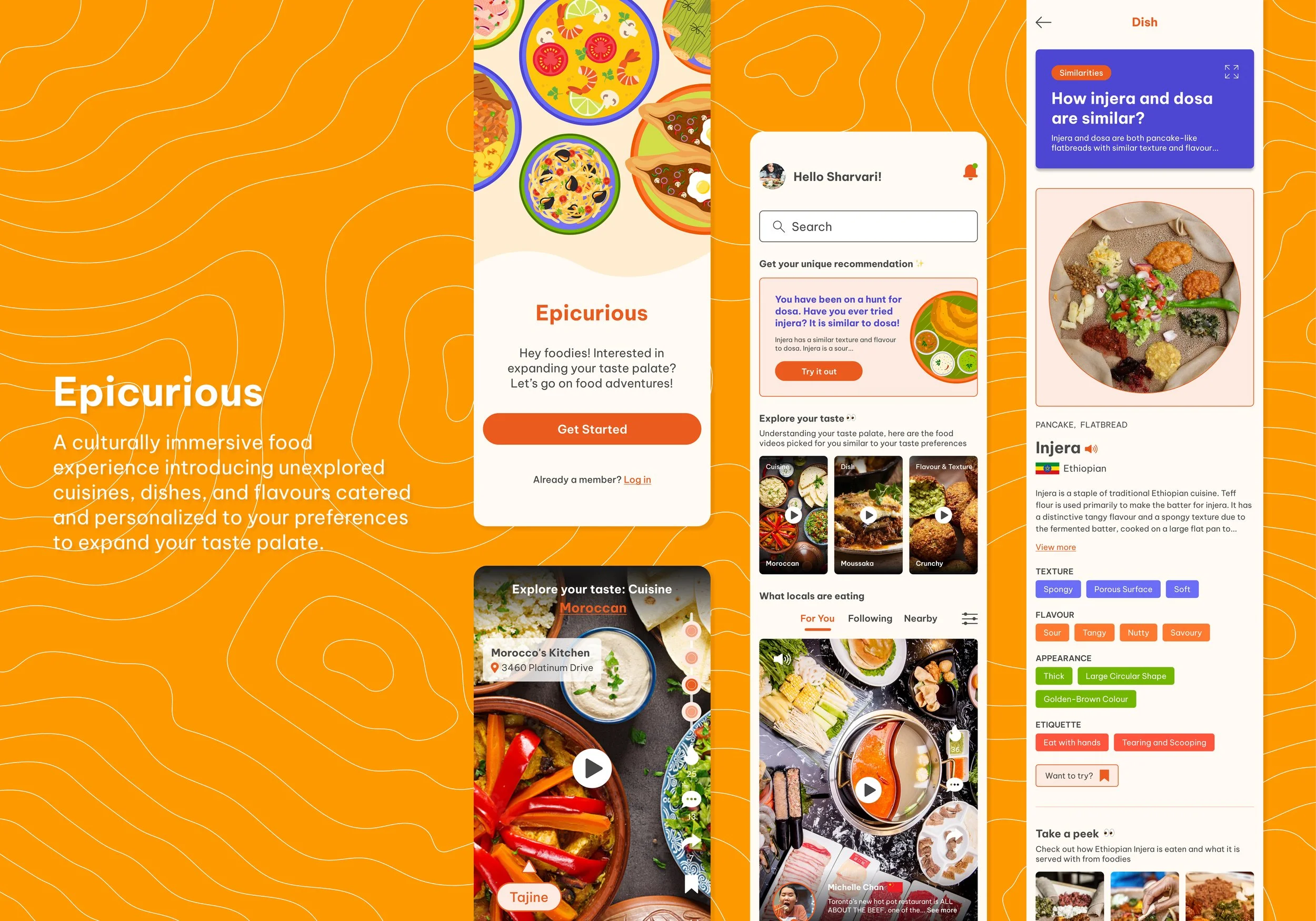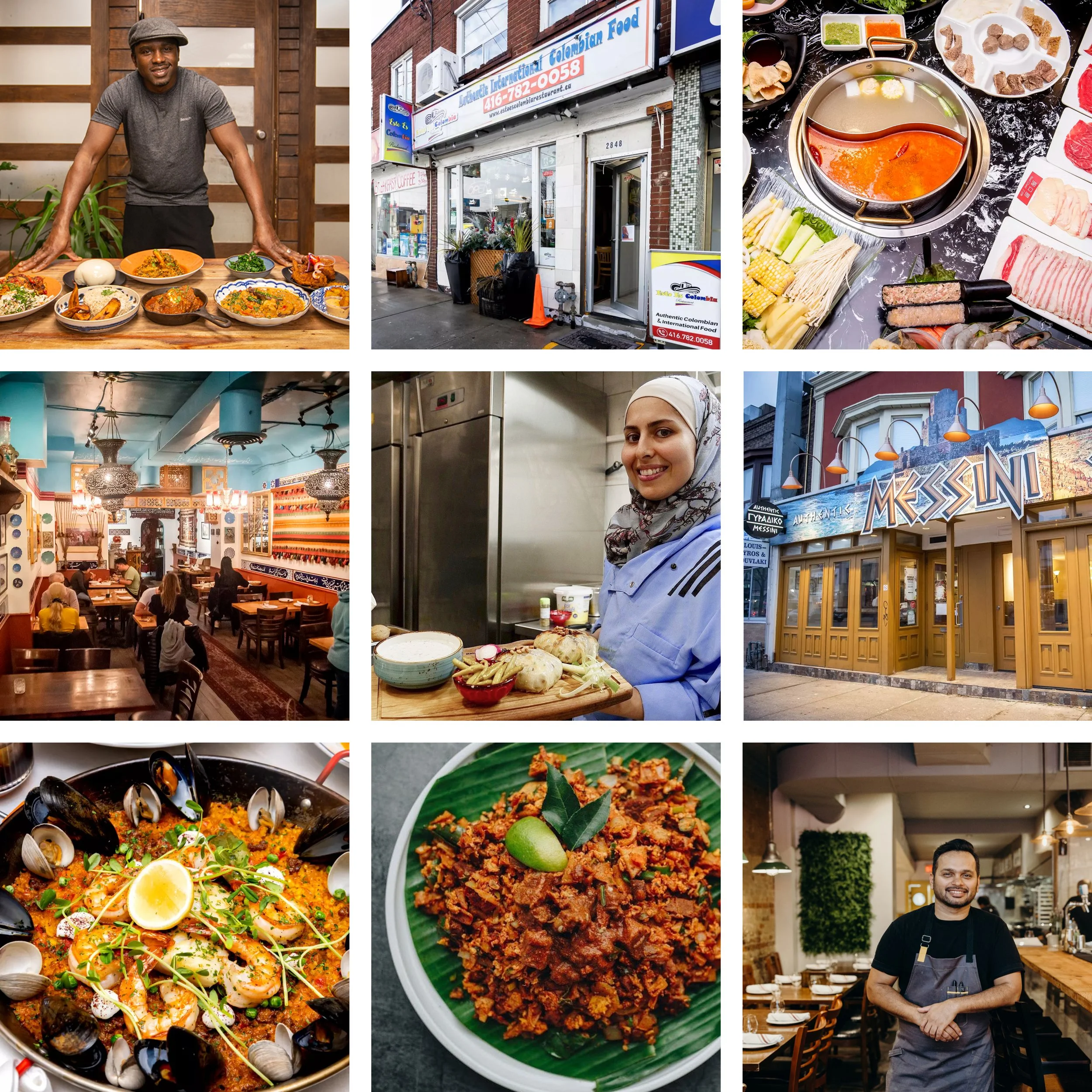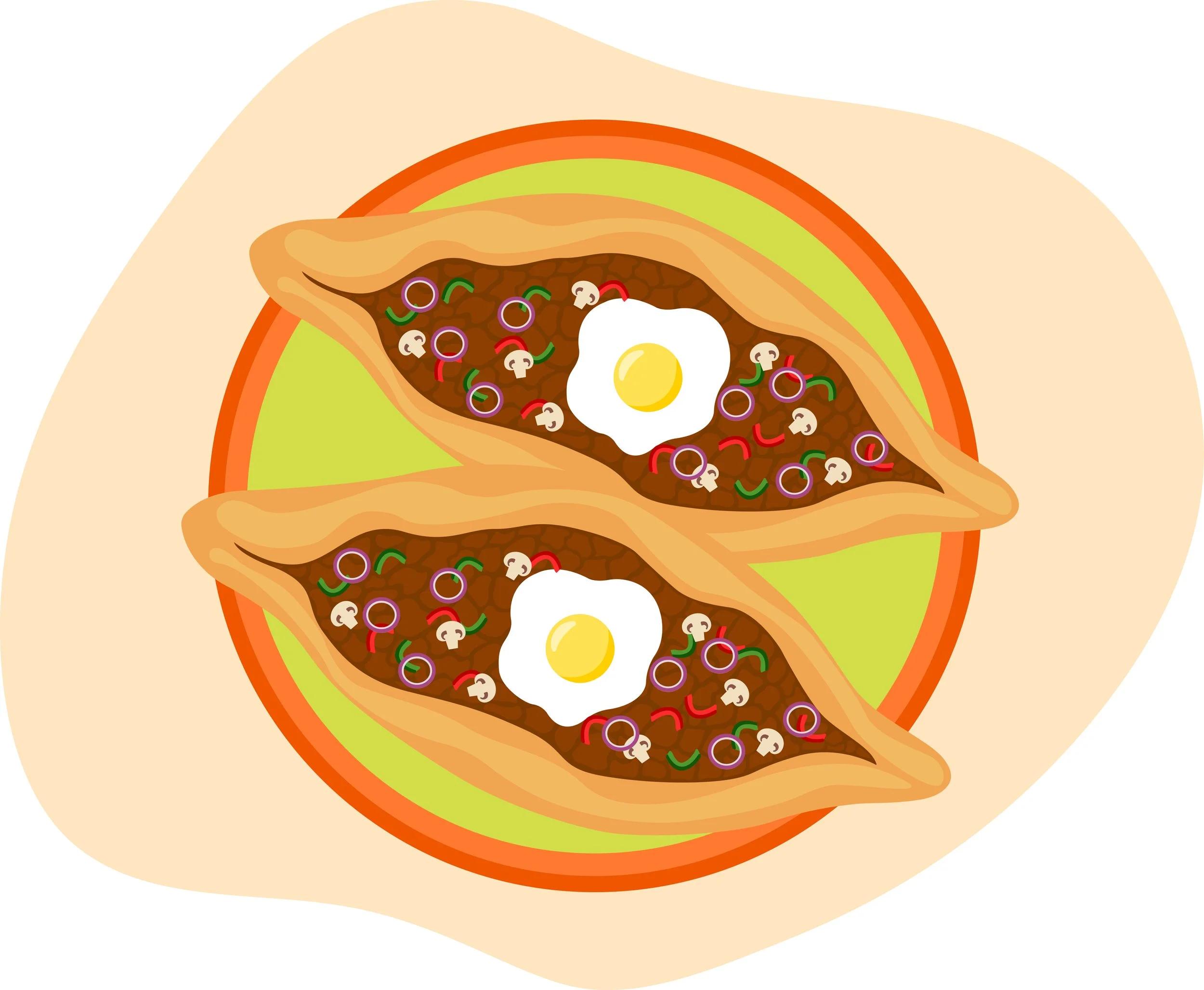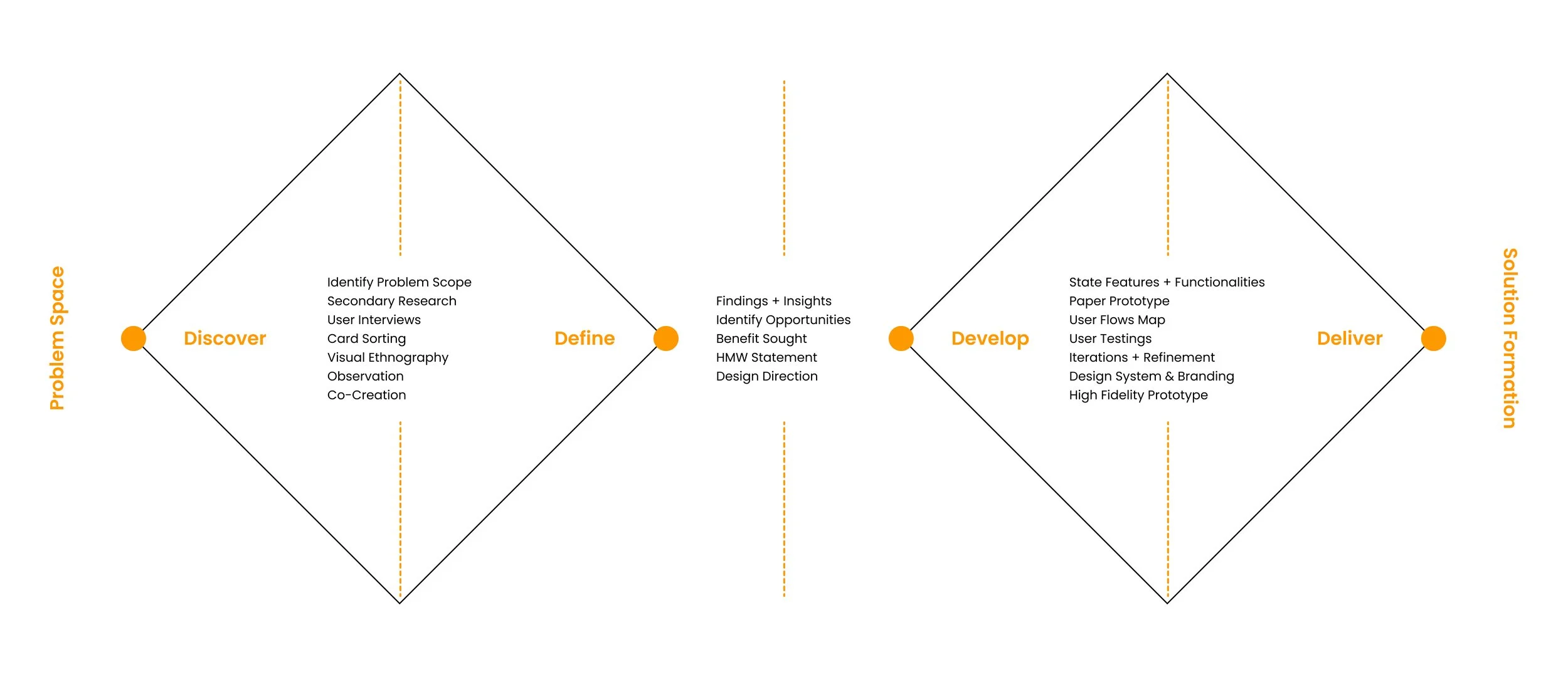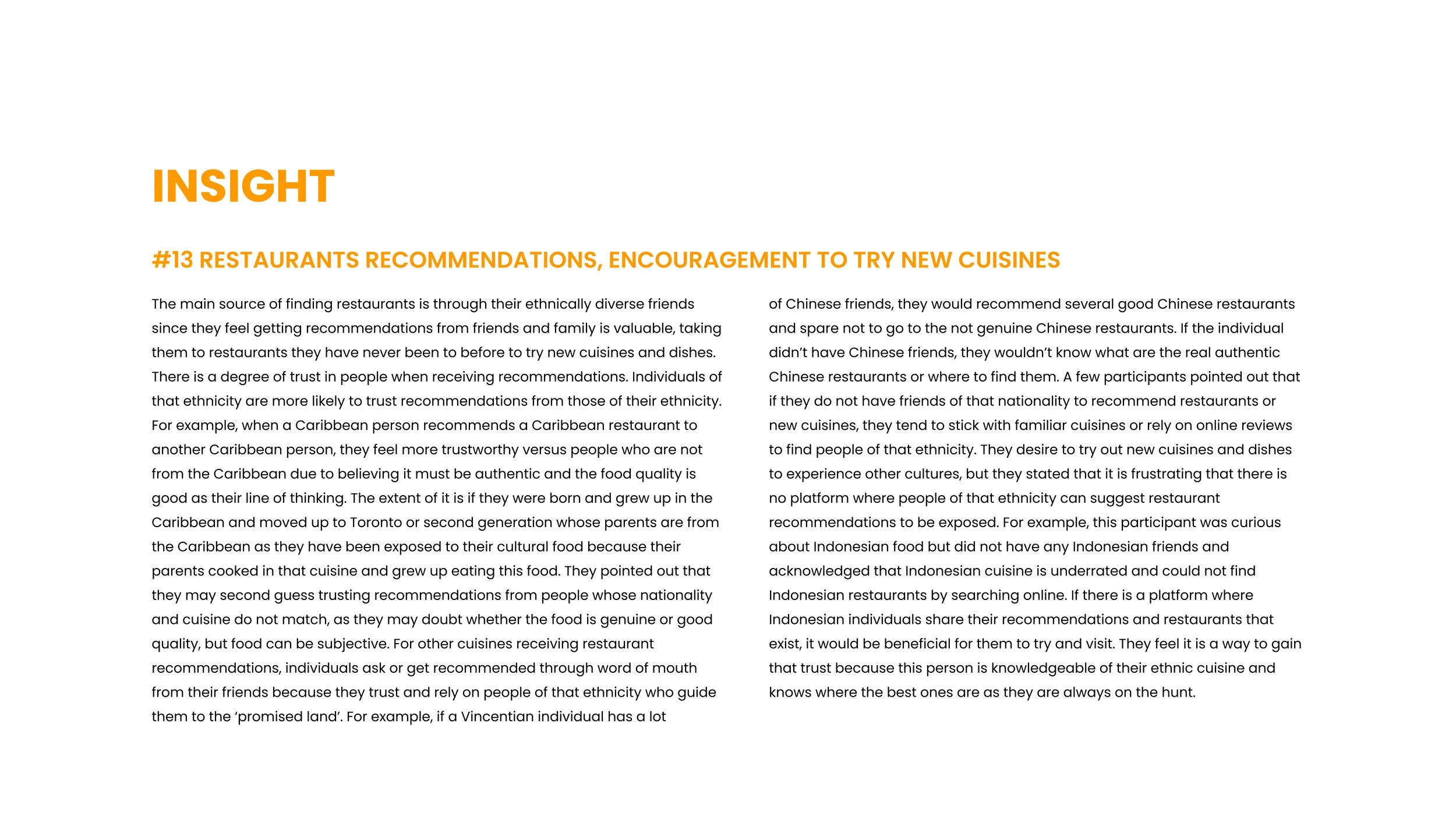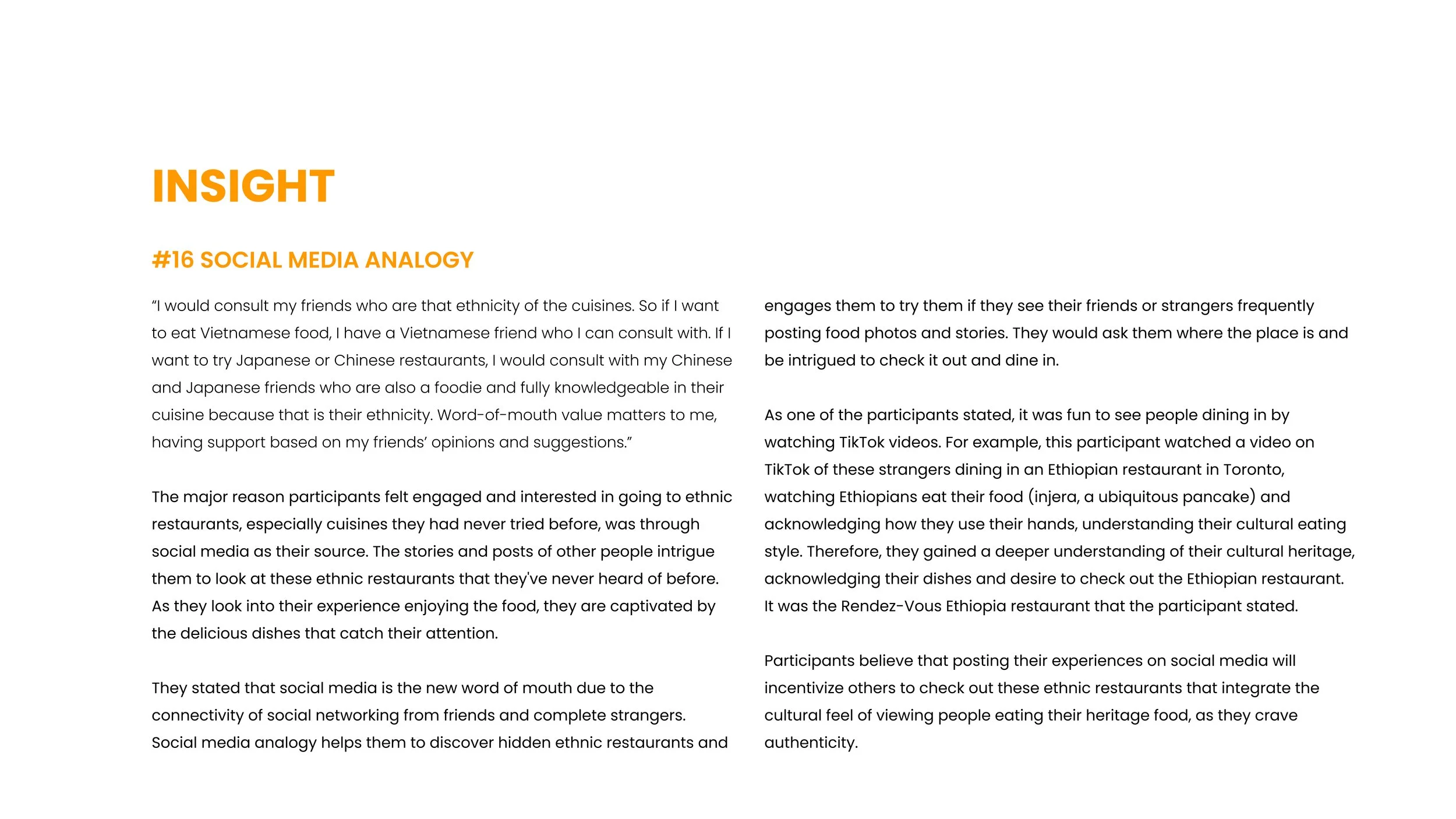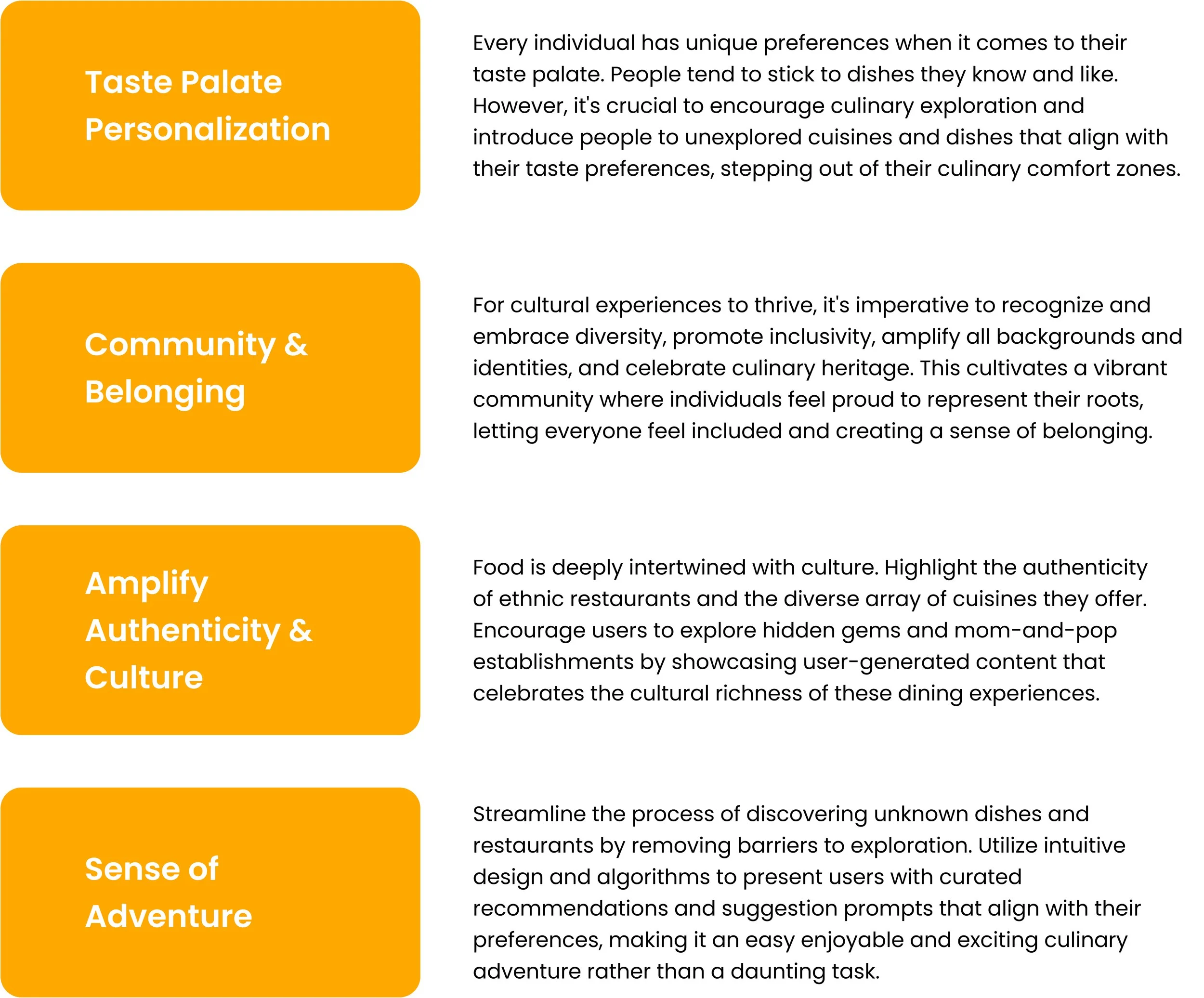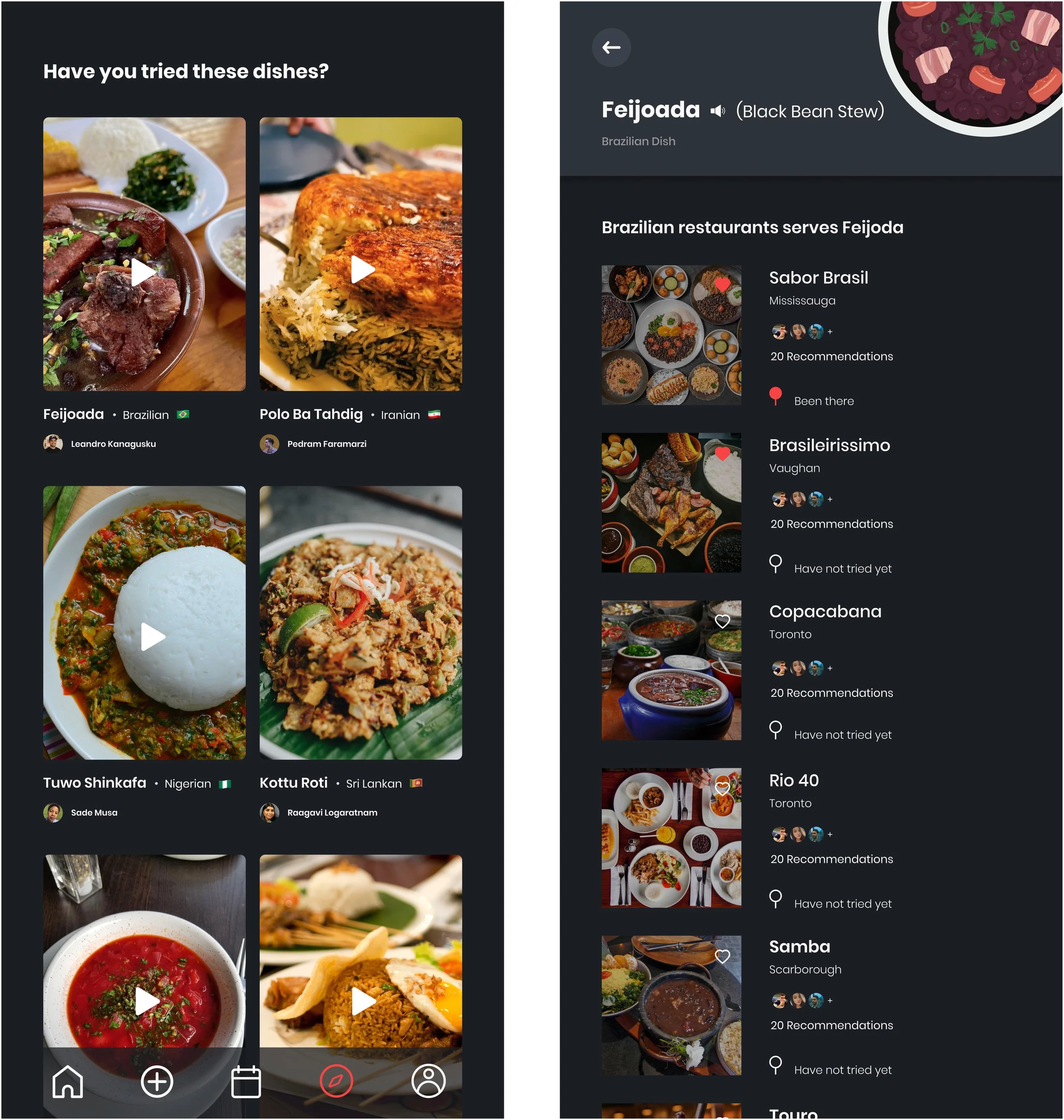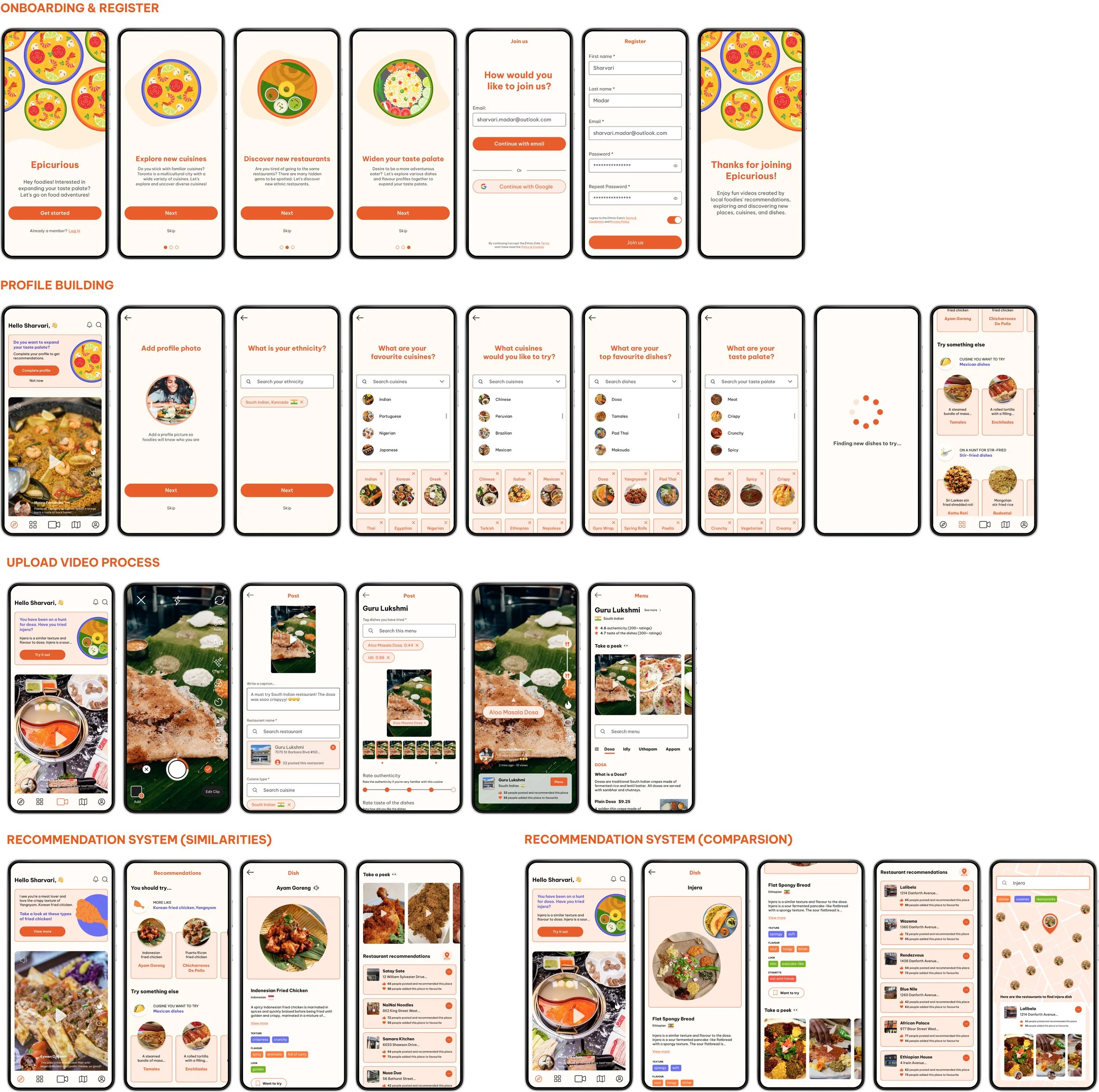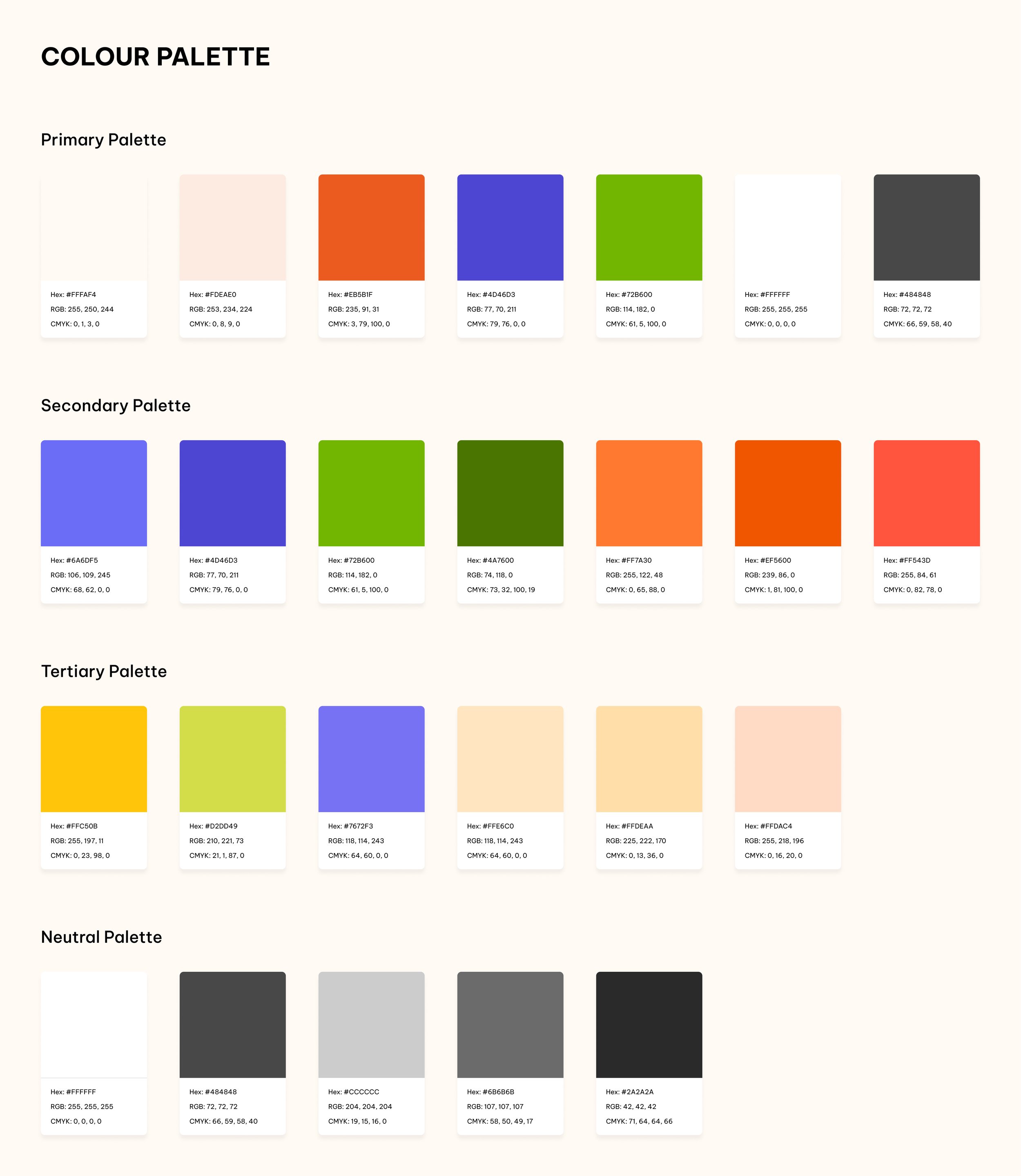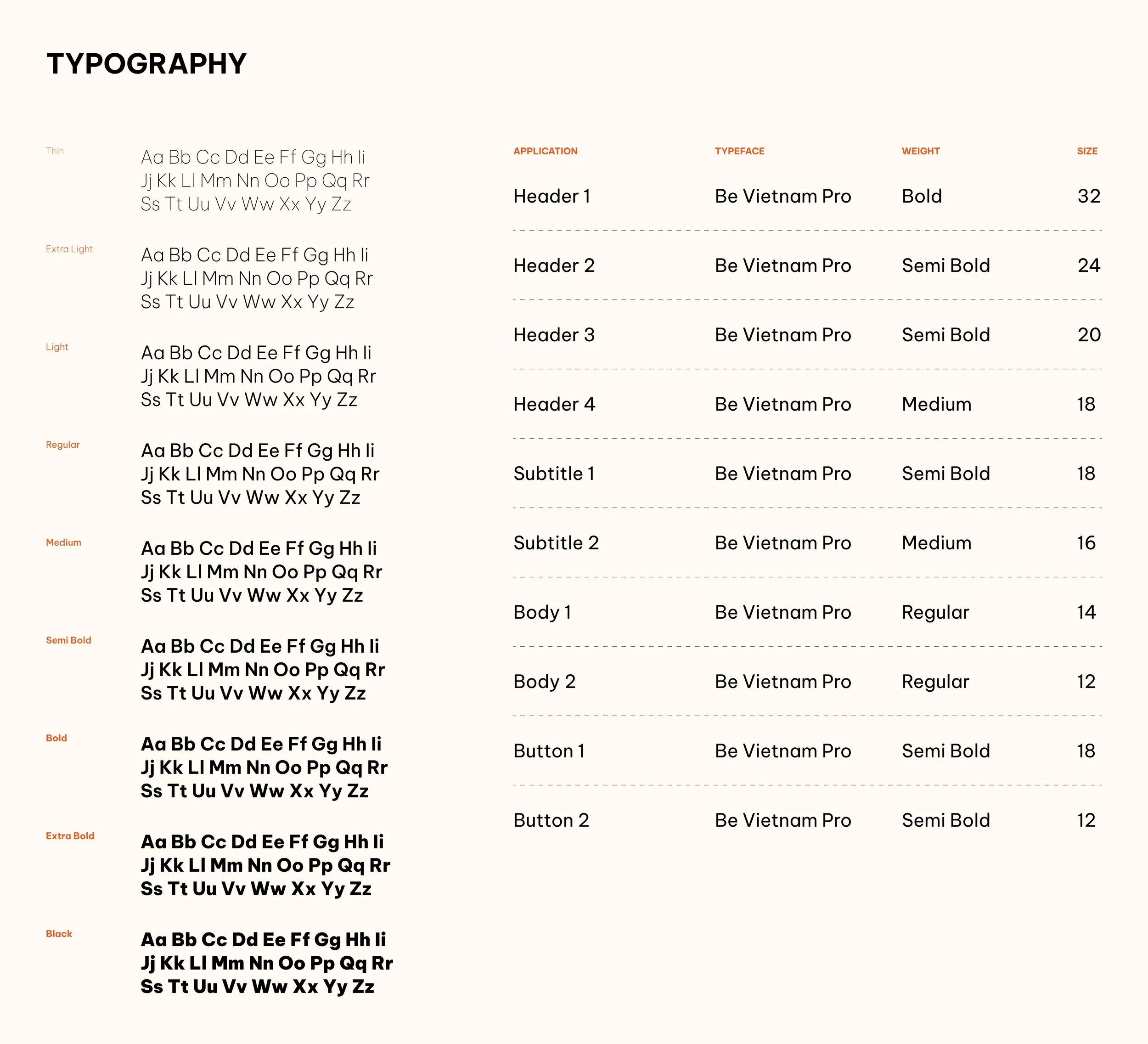Epicurious: Culturally Immersive, Expanding Your Taste Palate
Project Summary
Epicurious is a year-long thesis project. Epicurious is designed to help food enthusiasts expand their taste palate, cater to their preferences, and enrich their sense of food adventure. As residents of a multicultural city like Toronto, we have access to a diverse range of cuisines and cultural dishes, yet many of us often miss out on tasty dishes unknown to us. Here is where Epicurious comes in - the algorithm analyzes and determines users' taste preferences and generates personalized dishes recommendations paired with restaurant recommendations based on their palate.
DURATION: Eight Months
PROJECT TYPE: Individual Thesis Project
RESPONSIBILITIES: UX & UI Design, User Research, Product Thinking, Prototype, Illustrations, Visual Design, Narrative & Storytelling
TOOLS USED: Figma, Adobe Illustrator
Area of Opportunity
Over half of Toronto City residents were born outside of Canada, resulting in a diverse population representing nationalities around the globe. Toronto is home to an extensive immigrant population as the global ethnic foods are rooted and influenced by these ethnicities. As the food reflects the culture of the chef's homeland country, we are exposing ourselves to many ethnic and cultural foods, recognizing their cuisines and honouring their origins through their food. Therefore, Torontonians have access to a wide variety of cuisines from different cultural dishes for us to consume and experience due to many newcomers opening restaurants in the GTA that customers are nostalgic for and eager to try new foods, appreciating the unique richness of diversity and heritage.
The Problem
Food is central to the culture that immigrant communities settling in this country bring a taste of home. Therefore, when it comes to discovering and encountering their heritage food, the best way is through pop-ups and mom-and-pop independent restaurants consuming and experiencing their authentic dishes. However... are ethnic restaurants exposed enough to the public? Is the public aware of the majority of cuisines? Mom-and-pop family-owned restaurants are not being seen, and being on the search for mom-and-pop restaurants is challenging and rarely too visible, indicating they are known as hidden gems. The majority of the cuisines are underrated, primarily because popular cuisines, such as Chinese, Italian, Indian, Korean, Greek, Japanese, and Thai, are heavily elevated, but what about other cuisines like Ecuadorian, Barbadian, Nigerian, Ukrainian, Sri-Lankan, Mongolian, Iranian and so on? In this case, are individuals expanding their taste palate? This results in many cuisines being overlooked and continuing to be underrated, as well as many people unfamiliar with many dishes, not broadening their taste palate and not recognizing many dishes.
The Pain Point
Although people desire to expand their palates, incentivizing them is a challenge. The problem with broadening our palate is that it is unknown what dishes would match our preferences and satisfy our tastes. Exploring new cuisines may be challenging as we may feel reluctant if we are unfamiliar and unaware of these dishes, what they consist of, and their flavour profile. Hence, they continue to consume the cuisines and dishes they enjoy, staying within their familiarity. In addition, individuals expressed a desire to experience authentic restaurants they had never been to before, but when they ask their friends and family where they want to go, the response is often "I don't know" or uncertain where to look, or can't decide what to eat, resulting in them going to chain restaurants or familiar places and cuisines that they frequent which fails to amplify their food adventure. The people in their lives who are ethnically diverse are the best sources to gain recommendations for discovering new dishes and broadening their palates, but if they don't have that source, how else can they broaden their palates and discover new dishes from other cultures?

Design Challenge
How might we expand individuals' taste palates to cater to their preferences, increase their sense of food adventure, and incentivize them to explore new/unfamiliar cuisines to discover and experience different cultural dishes and ethnic restaurants?
Design Solution
Elevate your food journey with Epicurious, a mobile app for food enthusiasts. Discover and explore a world of tantalizing cuisines and dishes all tailored to your unique tastes to expand your palate and enrich your food adventure.
Epicurious is a user-generated platform that allows users to upload fun videos of their food adventures at ethnic restaurants while capturing mouth-watering dishes. Individuals are the most reliable source of recommendations as they know the must-try restaurants according to their ethnicity and knowledge of their cultural food, especially posting hidden gems of authentic restaurants that are unknown to many people. Since individuals are unknown and unaware of what dishes exist, they could miss out according to their tastes. This is where Epicurious's algorithm analyzes and determines their taste preferences based on their profile and activities on the application to generate targeted dish recommendations. Therefore, according to their taste palate, Epicurious identifies connections and comparisons to predict and tailor what users may want to try dishes in the future, generating personalized suggestion prompts, recommendation curations, and specially-tailored video clips, including pairing restaurant recommendations. As a result, individuals are broadening their taste palate through Epicurious, acknowledging what they will like, allowing users to discover and expose new dishes, cuisines, and restaurants that they haven't tried before, adding to their favourites and enriching their food adventures. In addition, Epicurious will generate restaurants that match your taste and your friends' preferences, taking the effort out of searching for a place to eat.
Benefit Sought
The benefit sought is to enhance individuals' culinary experiences by expanding their taste palates, catering to their preferences, and enriching their sense of food adventure. This is cultivated through the Epicurious platform, which is dishes driven and offers generating personalized dish recommendations paired with restaurant recommendations based on users' taste preferences, facilitates exploration of diverse cuisines and cultural dishes that have not been explored yet, and provides a user-generated platform for sharing food adventures and discovering hidden gem restaurants. Ultimately, the goal is to provoke an exciting experience by bringing an engaging and compelling approach to incentivize users to explore new and unfamiliar cuisines, broaden their culinary horizons, and enjoy a more diverse range of dining experiences, including having a sense of belonging that their native cuisine is available.
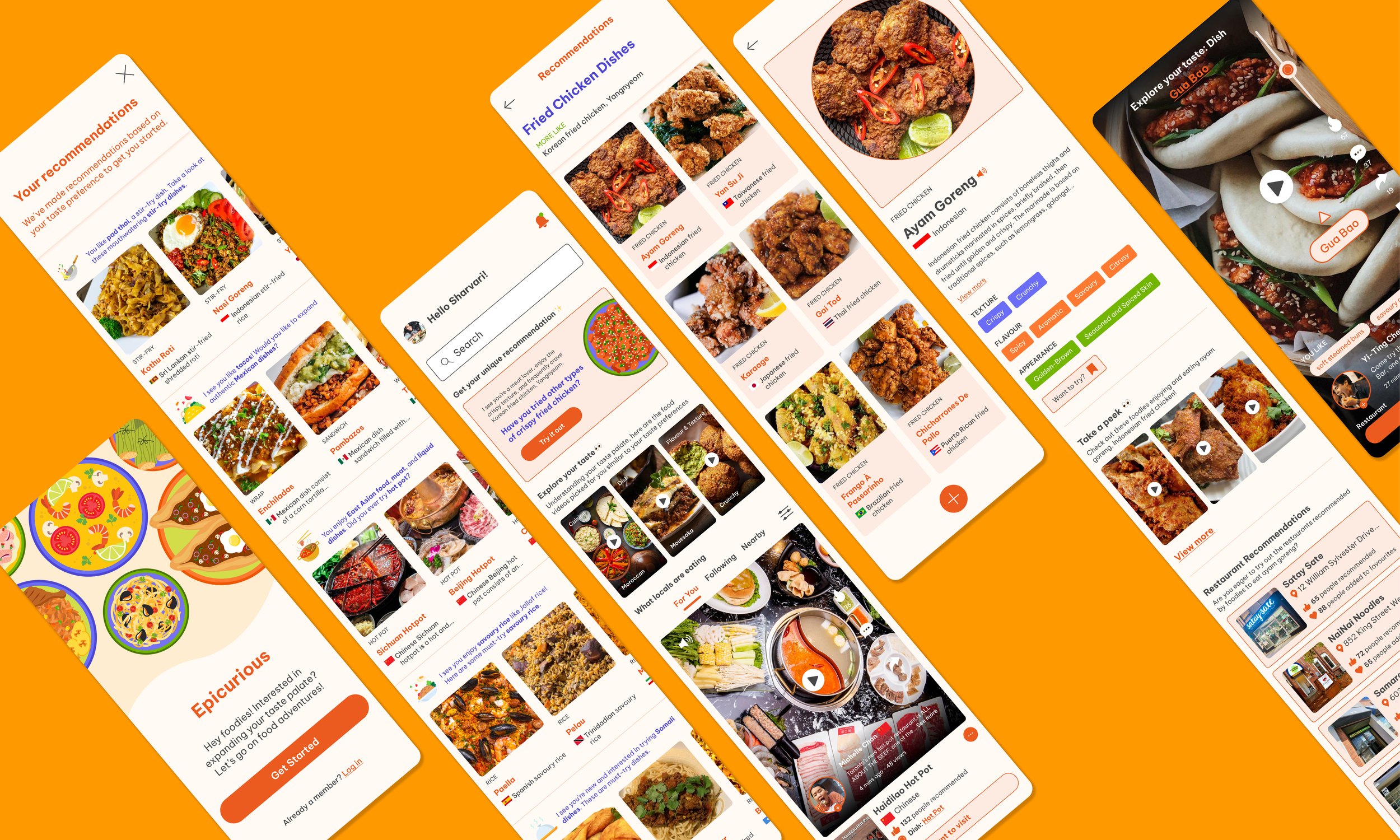
Double Diamond Design Process
01 Secondary Research
Throughout my secondary research initially, I aimed to emphasize the evident reasons why it is crucial to increase exposure to these mom-and-pop-owned restaurant establishments, as well as bring greater visibility to the underrepresented cuisines. These are the following reasons:
Economic Support: These entrepreneurs play a critical role and backbone in bringing growth to local economies and the culinary scene, as local business owners tend to have a vested interest in the community and its citizens fostering cultural diversity through food.
Cultural Diversity: Since immigrants brought their culture to Toronto, consumers benefit from mom-and-pop restaurants enriching in diversity as they share their flavours, ingredients, and recipes from their heritage, honouring and celebrating the diversity of these cuisines and playing a crucial role in expanding our taste palates.
Personalized Service: According to a study by Pentallect, consumers say that independent restaurants are much more likely to be rated highly for being special, unique, community-oriented, offering personalized service, and perceived as sharing consumers’ values as they have a deep connection to the community that large corporations cannot replicate.
Quality and Authenticity: Many mom-and-pop restaurants use recipes passed down through generations, often originating from the owners' families or cultural backgrounds, contributing to the authenticity of the cuisine as the food is made from scratch and experience the genuine essence of these dishes.
Community Belonging & Development: These mom-and-pop restaurants contribute to the vibrancy and identity of neighbourhoods as they foster a sense of community and belonging, amplifying all backgrounds and identities. One example is the mosaic of ethnic neighbourhoods that constitute Toronto, including Chinatown, Greektown, Little Italy, Little Tokyo, Korea Town, Portugal Village, Little India, Little Poland, and Little Jamaica. However, other cuisines are endangered and critically endangered. According to Global Toronto Eats recommends consumers support underrated cuisines like Cameroonian, Ecuadorian, Indonesian, Dutch, Palestinian, Singaporean, Haitian and many more to prevent the end of their business as people are not familiar with these cuisines or individuals don't even consider it due to how underrated they are.
02 Primary Research
In conducting 6 primary research methods, I primarily desire to examine their food adventures through cultural food exploration and ethnic restaurant experiences, gaining insight into their nationality and heritage cuisine and how they develop a sense of taste diversity. The following primary research methods I have conducted are:
SEMI-STRUCTURED INTERVIEW
Restaurant Finding & Restaurant Exposure
I conducted unstructured interviews to get to know each individual's restaurant experience based on their ethnicity, how often they encounter other nationalities, and an overall understanding of their food adventure experience. My goal was to understand people's general restaurant experiences regarding mom-and-pop restaurants, including whether they tend to patronize mom-and-pop restaurants more than chain restaurants, whether they are on the lookout for mom-and-pop restaurants and how individuals discover these establishments, as well as what barriers they face when searching for these establishments due to their lack of visibility and not exposed enough.CARD SORTING
Cuisines & Dishes Exploration
I conducted a card-sorting activity to analyze each individual's ranking of what cuisines they have consumed the most, which cuisines they have experienced the least, and identify why they haven't tried any other cuisines. I also developed and conducted another unstructured interview to gather information on their cuisine status, whether they believe they are thriving, doing okay, or endangered. In addition, I am interested in determining whether they are explorative and frequently exploring various cuisines, expanding their taste palate or if there are roadblocks to exploring new cuisines.VISUAL ETHNOGRAPHY
Menu & Ordering
I conducted a visual ethnography activity on different types of menus. I desire to put it to test whether participants have trouble with reading the menu or if they understand it. Generally, it is because on most ethnic restaurants' menus, the dishes have unfamiliar names and meanings in their language, or the description uses certain words that individuals may not understand because of unrecognizable ingredients. With my assumption, individuals do not order food if they don't recognize the dish's name. They select food that is familiar to them and do not try anything else. Therefore, I would like to put it to the test to look into what are the limitations when ordering dishes.OBSERVATION
Dining-In Experience
I conducted an observational research method to observe the consumers' ordering experience. Based on the observation, I was interested in whether a restaurant gains other ethnicities' customers or is predominantly that ethnic group of cuisine dining in or witnessing bringing in their friends to introduce their cuisine. I also want to look into, depending on the cuisine and restaurant, whether it is crowded or empty, looking into how recognizable it is. Another observation I desire to see is whether there is a barrier when ordering food, such as asking a lot of questions or if there is uncertainty or confusion due to a lack of familiarity with the dishes and ingredients.CO-CREATION
Sense of Food Adventure
The co-creation activity helped me to understand and uncover how users engage themselves to venture into ethnic restaurants. Participants stated when it comes to restaurants of their ethnicity, it is easy for them to enter the restaurant and check it out since it is their cultural nostalgic cuisine, as they eat their cultural dishes every day and grew up with these kinds of food. Resulting, they are always on a hunt for trying new restaurants in their ethnicity. However, this activity is to investigate when it comes to other ethnicities: what is the drive or motivation to go to these ethnic restaurants? What gives them the push? Trying new cuisines or cuisines that are unknown to individuals can be intimidating or hesitant to try. I intend to investigate how to implement this sense of engagement agitator for users to try these ethnic restaurants they could be missing out on.
03 Analyze Research & Gather Insights
After conducting the primary research methods with 14 participants, I externalized all the information I gained and compiled it into producing 16 insights. Here are the following insights:
04 Synthesize & Concept Direction
Having synthesized my research insight findings, I examined the data to identify and connect potential features and functions to address the various pain points expressed by the participants to inform the design decisions. To guide the design direction, I developed design principles that acted as a compass for determining which elements to incorporate to represent the prototype's purpose. Here are the following design principles:
Design Principles
05 Ideate & Concept Development
To start the development process, I created paper prototypes to brainstorm ideas and design user flows. This allowed me to test out initial concepts and determine how the prototype's features and functionalities should be structured and operated. I iterated through several rounds and versions, gradually improving the prototypes from low to medium to high fidelity. During this process, I made various changes, from completely overhauling the design concept to modifying and optimizing user flows. Additionally, I added, expanded, and enhanced features and functions through multiple user testing rounds by collecting insights, feedback, and suggestions from the participants.
Prototype Iterations Process
06 Visual Design & Style Guide
Colour Palette
By selecting a palette of bright and energetic colours, I aimed to capture the essence of cultural authenticity. These colours reflect the vibrancy and diversity of different cultures and help to evoke a sense of excitement and energy. The primary colours, nicely balanced by vivid orange, blue, and green, reflect the warmth of beige as they exude enthusiasm and vitality.
Typography
The rounded and friendly sans-serif typeface used for the branding and the entire app is a deliberate design choice that creates a welcoming and approachable interface.
Illustrations Style
To create a visually captivating prototype design that represents and celebrates cultural diversity and food authenticity, I achieved this by incorporating a playful, colourful, and vibrant design and illustration, which evokes and immerses users in a world of culture, cuisines, and dishes. The overall prototype design has an energetic and playful flair that emphasizes the brand's message and values, adding warmth and personality, which enhances user engagement.
Epicurious Final Product
Onboarding, Register, Discover & Home Page
The onboarding briefly introduces the application and its purpose. After that, users can register and sign up to start using the product. Once the users have registered, the Discover & Home page appears.
The Discover & Home page is a community page featuring videos of dishes videos from users sharing their restaurant experience and info. When the users upload their video, it will automatically appear under the Discover & Home page. This allows users to view people's restaurant hunting experiences, watching what dishes they have experienced that leave others excited and enticed when looking at appetizing dishes in motion with a never-ending stream of delicious content catching their attention. Users who post videos are known as recommendations for others to try and allow others to like, comment, and share. It will appear restaurant details, including the restaurant name, restaurant cuisine, how many people have recommended this place, and the dishes the user has tried.
The community video content is specifically meant for users who are browsing videos that are under the For You, Following, and Nearby pages. The For You page is packed with recommended video content that Epicurious has predicted the user will enjoy the most, based on their preferences that the user hasn't discovered yet. The Following page implies that the user follows the content they are drawn to and shares a similar interest to these foodies. Lastly, the Nearby page shows restaurants that are located close to the user.
Profile Building & Recommendation System Curation Type 1
Profile-building tasks are to input users' information, such as their ethnicity and ask users to answer questions and make selections that help the platform understand their food preferences. Epicurious uses profile building to identify and analyze users' taste palates. Once the user completes the profile process, Epicurious generates personalized recommendations tailored to their taste. These recommendations are not generic and are designed to expand the user's food horizons by suggesting dishes they may not have encountered before, including obscure dishes they may have never heard of. The recommendations are displayed on a dedicated page and are curated to reflect the user's unique taste.
Curation #1: Based on the user's selection through profile building, Epicurious acknowledges the user likes Pad Thai and the stir-fried method, hence will curate stir-fried dishes that the users have not tried yet, discovering these dishes.
Curation #2: If Epicurious notices the user frequently consumes vegetarian dishes due to analyzing the user’s data and activities on the platform, Epicurious curates and suggests similar vegetarian dishes based on the user's preferences.
Curation #3: If Epicurious acknowledges the user's favourite food based on their profile, their video uploads, and identifies the user’s patterns on the app, Epicurious curates similar to the user’s favourite food, such as Jollof Rice, curates savoury must-try rice dishes comparable to Jollof Rice.
Upload Video Process
Epicurious is a user-generating video-sharing social community-based application that allows users to create and share short-form videos of their restaurant experience, flooding mouthwatering dishes video feeds under the Home & Discover page. Users must upload a video recommendation of a restaurant in their ethnicity for others to acknowledge these are the authentic places, enlarging the underrepresented cuisines as word of mouth and people's recommendations are valuable and the ultimate source powering. Users can still upload videos if the cuisine is not correlated to their ethnicity as they believe it is a must-try restaurant to recommend to others. During the upload video process, users must include info on the restaurant name, cuisine, a caption based on their food experience, and quality & authenticity ratings. Once the video is uploaded, the menu is integrated into the restaurant post so that users can view what other dishes the restaurant offers.
Recommendation System Uniquely Yours Prompt Type 2
The second type of Epicurious recommendation system generates a unique prompt that delivers a highly personalized recommendation. Epicurious establishes the comparisons and connections, then predicts what dishes to generate that the individuals would want to try in the foreseeable future that match their taste palate and has not encountered yet.
Example #1 Flow: When Epicurious detects that a user frequently consumes Dosa dishes based on their video posts, or if Epicurious is picking up their activities and engagement on the app, Epicurious will recognize and analyze their preference and suggest a similar dish that the user has not tried yet. In this case, Epicurious recommends Injera, as it has a similar taste and flavour profile to Dosa. Since this may be an unfamiliar dish for the user, Epicurious will provide a detailed description of Injera, including its texture, flavour, appearance, and etiquette. Crucially, Epicurious will pair restaurant recommendations that serve Injera to check out, accompanied by videos of other individuals eating the Injera dish. As both Dosa and Injera are pancake-like dishes, Epicurious provides recommendations for other similar dishes to explore and look into.
Example #2 Flow: Epicurious generates a unique personalized prompt, noticing you are a meat lover, enjoy the crispy texture, and frequently crave Korean fried chicken Yangnyeom, Epicurious will generate various types of crispy chicken that are similar to Korean fried chicken but unknown to you. It will also provide you with detailed descriptions of these crispy fried chicken and recommend restaurants where you can find them.
Example #3 Flow: Epicurious generates a unique personalized prompt, noticing you love tacos, and if you desire to expand your Latin palate, try something similar to taco-like. Epicurious will generate a specific dish, such as Arepas since they are both flatbread-based, versatile filling, and handheld. If the user never heard of Arepas, it will provide the dish description to learn about the dish, along with restaurant recommendations where you can try them. In addition, since Tacos and Arepas are Latin street foods, Epicurious provides recommendations for other similar Latin street foods to explore and look into.
Recommendation System Video Clips Type 3
Since Epicurious is centric on short-form videos capturing and highlighting the world of cultural dishes. As a result, the third type of recommendation system is video clips, categorized as cuisines, dishes, and flavours & textures. The categorized video clips help users explore their tastes through curated clips tailored for individuals delivering similar to their preferences, cultivating their palate.
Cuisines video collection: For example, when users browse through the video collection of cuisines, the video component features what is the cuisine (Moroccan), tagged dishes (Tajine), why the user will the cuisine (heavy on vegetables), and also the user can view more restaurants of the cuisine (Moroccan restaurants) to look into.
Dishes video collection: For example, when users browse through the video collection of dishes, the video component features what is the dish that is tagged (Picanha), why the user will like the dish (juicy grilled tender beef), as well as what restaurants offer this dish along with what is the cuisine (Casa Tropical, Brazilian). In addition, if the user is interested in juicy grilled tender beef, Epicurious can offer juicy grilled tender beef recommendations suited for the user.
Flavours & textures video collection: For example, when users browse through the video collection of flavours and textures, the video component features what is the flavour or texture (spicy), what is the dish that is tagged (Papa a la Huancaína), and what restaurant offers the dish along with what is the cuisine (Los Chicos Brasa restaurant, Peruvian). In addition, if the user is interested in the spicy flavour, Epicurious can offer spicy dish recommendations suited for the user.
Recommendation System Combination Prompt Type 4
The fourth type of Epicurious recommendation system generates a combination prompt, another version of a highly personalized recommendation. Epicurious employs an AI algorithm to analyze user data and activities that lead Epicurious to recognize and combine certain nuances that the user often enjoys, creating an overall taste summary. As a result, the system surprises the user with a video clip, revealing the dish that matches their preferences. This surprise component adds an element of excitement to the recommendation, a dish they have never heard of and tried before in anticipation of trying it.
Combination 1: For example, Epicurious analyzes the user's taste palate and that there are particular nuances that the user often goes for: cheese-based, rice-based, and spicy sauce. There is this combo in a dish a user has not tried before, revealing the dish with a surprise video clip - in this case, it is Chiles Rellenos dish.
Combination 2: For example, Epicurious analyzes the user's taste palate and that there are particular nuances that the user often goes for: pasta, rice, legumes, and lentils. There is this combo in a dish a user has not tried before, revealing the dish with a surprise video clip - in this case, it is a Koshary dish.
Combination 3: For example, Epicurious analyzes the user's taste palate and that there are particular nuances that the user often goes for: crispy chicken, creamy sauce, and savoury. There is this combo in a dish a user has not tried before, revealing the dish with a surprise video clip - in this case, it is Katsuya.
User’s Profile
The user's profile contains their picture, details about their name, identity, and the accounts they follow. As food enthusiasts, they engage and seek out other foodies who share similar interests. For instance, if a user is particularly fond of Moroccan cuisine, they are likely to follow other users who frequently dine at Moroccan restaurants, to discover new Moroccan restaurants they hadn't heard of, or follow other users due to drawn to their food adventures for them to gain exposure to new restaurants, cuisines, and dishes.
The profile-building process is stored under the user's profile. It contains information about their favourite cuisines, dishes, and flavours & textures. Users can go back to adjust and add their selections as their tastes change over time. Additionally, the profile also stores highly personalized recommendation prompts for the user can look back to.
The user's saved posts are stored under their profile categorized as "Want to Try" and "Have Tried," while the videos they have uploaded and recommended are also stored under their profile. Under the Want to Try saved page, categorize what dishes, cuisines, and restaurants they want to encounter saved content. Under the Have Tried page, Epicurious acknowledges the user's efforts of how much they have ventured out based on listing the content of the overall dishes, cuisines, and restaurants as the numbers are rising, indicating how much they have explored and exposed, expanding their food horizons and enriching culinary experience, reaffirming to the user of how far they have come.
Foodie’s Group, Paired Restaurant Recommendations
Users can create foodie groups with their friends. Deciding on a restaurant to go out with friends can be a daunting task, especially when considering everyone's preferences. Imagine starting a foodie group with your friends and having Epicurious analyze and examine your tastes to generate restaurant recommendations that everyone will love. With Epicurious, you can guarantee that your friends will be satisfied with the restaurants' options, making your foodie adventures even more enjoyable and allowing you to venture out more frequently. Additionally, Epicurious will rank the top cuisines based on what everyone shares as their favourites.
Personalized Events Recommendation
It is important to stay informed about street food vendors, festivities, and pop-up events that may eventually grow into small family-owned restaurants, supporting and sustaining these vendors and chef entrepreneurs is crucial. Epicurious offers an event page where users can find street food, festivities, and pop-ups to explore upcoming events. In addition, a personalized recommendation prompt will appear to the user as Epicurious acknowledges this is the event the user definitely would want to attend. For example, Epicurious notices the user is craving authentic pasta lately, well just in luck, a pasta vendor event is coming near you that the user can check out to consume authentic pasta. On the event page, the user can view the place, date, cuisine type, what dishes they will offer, and video peeks of previous occurrences.
Reflection
Epicurious was my passion project. As a food enthusiast and adventurer, I believe it is crucial to broaden my taste horizons. Living in Toronto, a multicultural city with access to a diverse range of cuisines and cultural dishes, I feel fortunate to have so many culinary options to explore, but it is still unknown what is out there, which is why Epicurious was born.
Having conducted extensive research through secondary and primary research, I am convinced that this challenge is not only worthwhile but also holds immense potential for success with the help of uncovering and identifying participants' insights and perspectives, gaining many findings of the problem space.
Throughout the prototype design process development was the most challenging phase as I had trouble directing the algorithm to establish a unique recommendation system and how mom-and-pop restaurants can gain exposure for individuals to explore underrepresented cuisines, bringing visibility and recognition to these ethnic restaurants. I was too fixated on shedding light on ethnic restaurants and relying on existing restaurant platform curations to spark concepts, which resulted in poor execution or looked into an AI generator, asking back and forth questionnaires to get a restaurant selection based on the users' responses, but this will fail users to get engaged due to how lengthy and mechanical it is.
This is where I gained a spark through the co-creation method. The participants discussed and stated if there is a curation of top Nigerian restaurants you must try (since Nigeran is one of the underrepresented cuisines), what will make the individual engage and encourage them to try Nigerian restaurants? Does it cater to my taste palate? How will I know I will like Nigerian dishes? This guidance significantly pushed me to aim in a different direction, in addition to gaining insight and suggestions on starting with the profile-building process, which focuses primarily on broadening people's taste palate based on their taste preferences. And, instead of focusing on the ethnic restaurants, focus on the dishes for users to find a match based on their taste. Once they find a match, for example, I love Sri Lankan crispy patties, if there is another dish similar to Sri Lankan patties, such as Spanish empanadas, this user expands their taste palate because the user has not tried it before, and it is basing on their preferences and can gain restaurant recommendations from this approach, trying a new restaurant. This critique was the light end of the tunnel.
By designing with various AI recommendation systems implemented in my final design prototype, the participants were ecstatic and found the application both unique and engaging. They believe this application will enable them to expand their taste palate and expose and learn multiple cuisines and cultural dishes that were unknown to them in an engaging and fun manner. They expressed their willingness to use it daily if this application were launched to enrich their food adventures. With such positive feedback from participants, it's clear that this application has the potential to revolutionize the market and felt proud of the final design prototype outcome. I want to thank my participants and my thesis professor's guidance believing the delivery of Epicurious application was beneficial based on people's impressions of how captivated they were.


